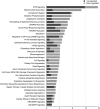Proteomic Analysis of Urothelium of Rats with Detrusor Overactivity Induced by Bladder Outlet Obstruction
- PMID: 29414759
- PMCID: PMC5930411
- DOI: 10.1074/mcp.RA117.000290
Proteomic Analysis of Urothelium of Rats with Detrusor Overactivity Induced by Bladder Outlet Obstruction
Abstract
Overactive bladder (OAB) syndrome is a condition that has four symptoms: urgency, urinary frequency, nocturia, and urge incontinence and negatively affects a patient's life. Recently, it is considered that the urinary bladder urothelium is closely linked to pathogenesis of OAB. However, the mechanisms of pathogenesis of OAB at the molecular level remain poorly understood, mainly because of lack of modern molecular analysis. The goal of this study is to identify a potential target protein that could act as a predictive factor for effective diagnosis and aid in the development of therapeutic strategies for the treatment of OAB syndrome. We produced OAB in a rat model and performed the first proteomic analysis on the mucosal layer (urothelium) of the bladders of sham control and OAB rats. The resulting data revealed the differential expression of 355 proteins in the bladder urothelium of OAB rats compared with sham subjects. Signaling pathway analysis revealed that the differentially expressed proteins were mainly involved in the inflammatory response and apoptosis. Our findings suggest a new target for accurate diagnosis of OAB that can provide essential information for the development of drug treatment strategies as well as establish criteria for screening patients in the clinical environment.
© 2018 by The American Society for Biochemistry and Molecular Biology, Inc.
Figures






References
-
- Abrams P., Cardozo L., Fall M., Griffiths D., Rosier P., Ulmsten U., van Kerrebroeck P., Victor A., Wein A., and Standardisation Sub-committee of the International Continence, S. (2002) The standardisation of terminology of lower urinary tract function: report from the Standardisation Sub-committee of the International Continence Society. Neurourol. Urodyn. 21, 167–178 - PubMed
-
- Milsom I., Abrams P., Cardozo L., Roberts R. G., Thuroff J., and Wein A. J. (2001) How widespread are the symptoms of an overactive bladder and how are they managed? A population-based prevalence study. BJU Int. 87, 760–766 - PubMed
-
- Stewart W. F., Van Rooyen J. B., Cundiff G. W., Abrams P., Herzog A. R., Corey R., Hunt T. L., and Wein A. J. (2003) Prevalence and burden of overactive bladder in the United States. World J. Urol. 20, 327–336 - PubMed
-
- Irwin D. E., Milsom I., Hunskaar S., Reilly K., Kopp Z., Herschorn S., Coyne K., Kelleher C., Hampel C., Artibani W., and Abrams P. (2006) Population-based survey of urinary incontinence, overactive bladder, and other lower urinary tract symptoms in five countries: results of the EPIC study. Eur. Urol. 50, 1306–1314; discussion 1314–1305 - PubMed
-
- Oelke M., Baard J., Wijkstra H., de la Rosette J. J., Jonas U., and Hofner K. (2008) Age and bladder outlet obstruction are independently associated with detrusor overactivity in patients with benign prostatic hyperplasia. Eur. Urol. 54, 419–426 - PubMed
Publication types
MeSH terms
Substances
LinkOut - more resources
Full Text Sources
Other Literature Sources
Medical

